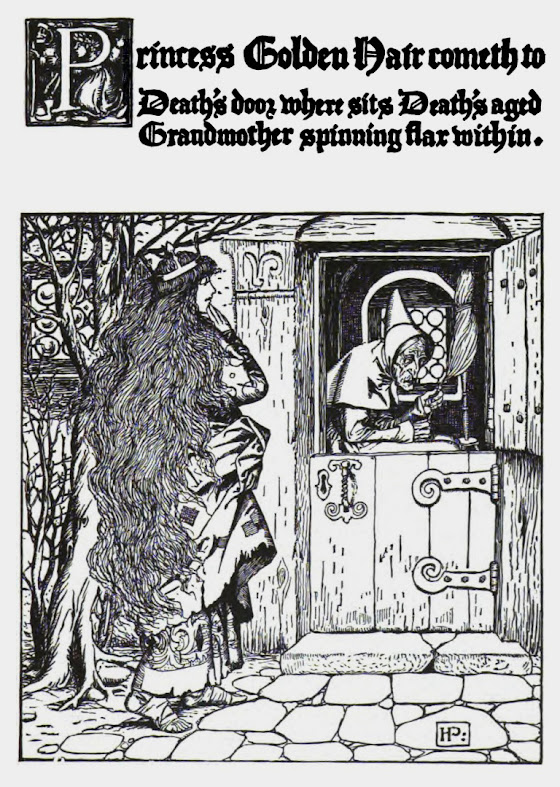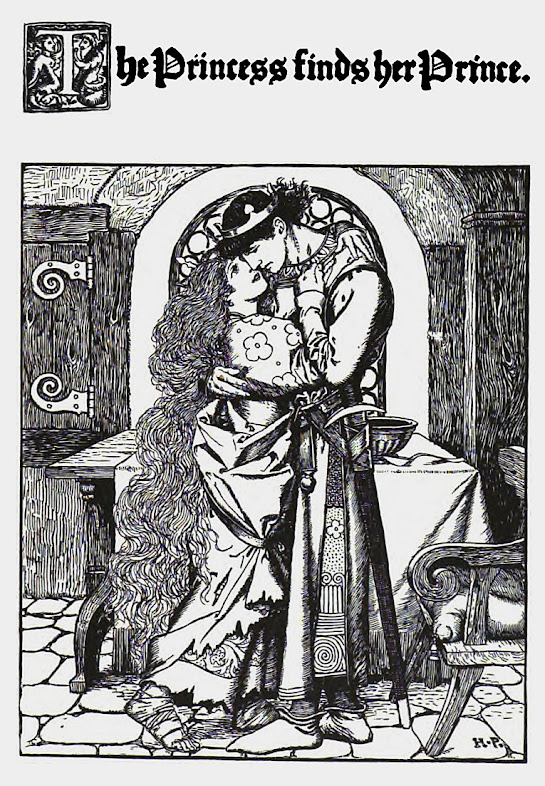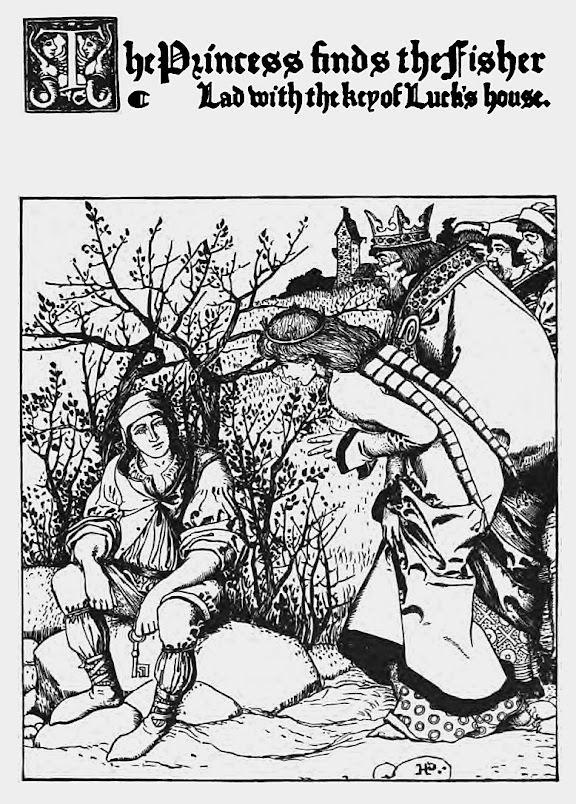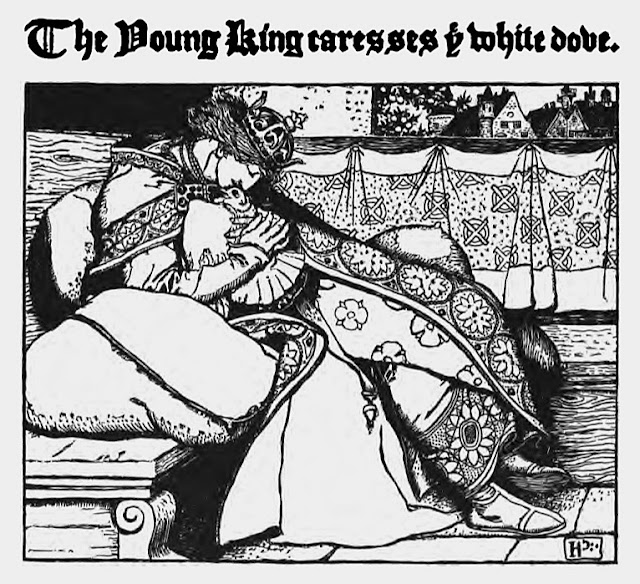Howard Pyle (1853, Wilmington Del. - 1911, Florence) was one of America’s most popular illustrators and storytellers at the end of the 19th century during a period of explosive growth in the publishing industry. His illustrations appeared in magazines like Harper’s Monthly, St. Nicholas, and Scribner’s Magazine, gaining him both national and international exposure. The broad appeal of his imagery made him a celebrity in his lifetime.
Pyle studied at the Art Student’s League, New York City, and first attracted attention by his line drawings after the style of Albrecht Dürer. His magazine and book illustrations are among the finest of the turn-of-the-century period in the Art Nouveau style. Pyle wrote original children’s stories as well as retelling old fairy tales. Many of Pyle’s children’s stories, illustrated by the author with vividness and historical accuracy, have become classics—most notably The Merry Adventures of Robin Hood (1883); Otto of the Silver Hand (1888); Jack Ballister’s Fortunes (1895); and his own folktales, Pepper & Salt (1886), The Wonder Clock (1888), and The Garden Behind the Moon (1895).
In 1894, he began teaching illustration at the Drexel Institute of Art, Science, and Industry. Among his students there wer valet Oakley, Maxfield Parrish, and Jessie Wikcox Smith. After 1900, he founded his own school of art and illustration named the Howard Pyle School of Illustration Art. Scholar Henry C. Pitz later used the term Brandywine School for the illustration artists and Wyeth family artists of the Brandywine region, several of whom had studied with Pyle. He had a lasting influence on a number of artists who became notable in their own right; N.C. Wyeth, Frank Schoonover, Thornton Oakley, Allen Tupper True, Stanley Arthur, and numerous others studied under him.
Later Pyle undertook mural paintings, executing, among others, The Battle of Nashville (1906) for the capitol at St. Paul, Minn. Dissatisfied with his style in painting, he went to Italy for further study but died shortly afterward. Pyle had established a free schoolof art in his home in Wilmington, where many successful American illustrators received their education.
Pyle travelled to Florence, Italy in 1910 to study mural painting. He died there in 1911 of a sudden kidney infection (Bright’s Disease).
For earlier works by Howard Pyle see parts 1-3 also.
This is part 4 of a 13-part series on the works of Howard Pyle:
1887 The Wonder Clock:
Frontispiece Title Page
The Wonder Clock, or four & twenty marvellous Tales, being one for each hour of the day
pen and ink 26 x 17.9 cm
The Metropolitan Museum of Art, New YorkBearskin
The Baby drifts in the basket down the river to the reeds beside the bank where the she-bear finds it.Bearskin
Bearskin slayeth ye Dragon but will not go with ye Princess to ye castle.Bearskin
Thus the Princess sits and weeps and weeps.Bearskin
Bearskin and ye swineherd have a grand feast.The Water of Life
The young king looks upon ye beautiful picture which the stranger showeth him.The Water of Life
The North Wind flies with ye faithful Servant.The Water of Life
The young King bringeth ye cup of water of life to the beautiful Queen.The Water of Life
The faithful Servant gives ye young king ye golden bracelet from his wrist as the other desires.How One Turned his Trouble to Some Account
The Brave Soldier bringeth his Trouble to ye town along with him.How One Turned his Trouble to Some Account
Here the Brave Soldier brings his trouble before the King to find if it shall follow him wherever he goes.How One Turned his Trouble to Some Account
The three Giants fight one another like fury.How One Turned his Trouble to Some Account
The rich man takes home money and trouble.How Three Went Out into the Wide World
The Grey Goose goes out into the wide world, where she and a discontented Sausage meet the Cock and the fox.How Three Went Out into the Wide World
The Great Red fox goes to call on neighbour Cock at his house because he will crow in the morn.How Three Went Out into the Wide World
The Great Red fox calls upon the Sausage.How Three Went Out into the Wide World
The Great Red fox rests softly at home.The Clever Student and the Master of Black Arts
A Princess walks beside ye water, into whose basket
leaps ye ring.The Clever Student and the Master of Black Arts
The Clever Scholar remains a Ruby Ring no longer, having regained his own true shape.
The Clever Student and the Master of Black Ats
The Master of Black Arts bringeth a curious litte Black Hen to the KingThe Clever Student and the Master of Black Arts
What happened to the Master of Black Arts after
all his tricks.The Princess Golden Hair and the Great Black Raven
The King being lost in ye forest meets with the Great
Black Raven.The Princess Golden Hair and the Great Black Raven
Princess Golden Hair, drinketh from the golden cup & touches neither ye silver nor ye clay.The Princess Golden Hair and the Great Black Raven
Princess Golden Hair cometh to Death's door where sits Death's aged Grandmother spinning flax within.The Princess Golden Hair and the Great Black Raven
The Princess finds her Prince.Cousin Greylegs, the Great Red Fox and Grandfather Mole
Cousin Greylegs and the Great Red fox go together
to ye fair.Cousin Greylegs, the Great Red Fox and Grandfather Mole
Cousin Greylegs steals away from the inn, carrying off a bag full of this & that with him.Cousin Greylegs, the Great Red Fox and Grandfather Mole
The Great Red fox meets ye old, blind Mole.Cousin Greylegs, the Great Red Fox and Grandfather Mole
The Great Red fox beareth all that he can.One Good Turn Deserves Another
Father Longlegs, the Stork, puts the Fisher Lad in ye way of catching a strange fish in his nets.One Good Turn Deserves Another
The Fisher Lad cometh to the Grey Master's house.One Good Turn Deserves Another
The Grey Master is caught in the stream and is swept away, but ye Fisher Lad crosses it dry-shod.One Good Turn Deserves Another
The Princess finds the Fisher Lad with the key of
Luck's house.The White Bird
The Princess knocks at the door of the poor, mean, little house and not the great, rich one.The White Bird
The Prince finds ye three giants sleeping under the tree of life & snoring away like everything.The White Bird
The Prince finds the sword of brightness where sits
an old man.The White Bird
The Prince sits down beside ye garden gate and only
one knoweth him.How the Good Gifts Were Used by Two
Saint Nicholas knocks at the rich man's door but finds only a chill welcome & cold faring.How the Good Gifts Were Used by Two
Saint Nicholas blesses the poor man's crock and bowl with food and drink.How the Good Gifts Were Used by Two
The Poor man welcomes Saint Christopher to his house.How the Good Gifts Were Used by Two
The rich man spreads a feast for the Saints.How Boots Befooled the King
Peter goes to the castle to befool the King, dressed in his finest clothes.How Boots Befooled the King
Paul comes home again from the king's castle with no luck.How Boots Befooled the King
The old woman smashes pots and things at Boots' bidding.How Boots Befooled the King
The Councilor finds one in the Sack who teaches him wisdom.The Step-Mother
The Step-daughter follows ye golden ball in spite of herself.The Step-Mother
The Step-Mother bringeth mischief upon the Young Queen by sundry magic spells.The Step-Mother
The Young King caresses ye white dove.Master Jacob
Master Jacob comes to ye town with his fine, fat pig and there falls in with Priest and Provost.Master Jacob
Mater Jacob takes takes his black goat to town.Master Jacob
The Priest, the Provost and the Master Mayor blow and blow the little tin trumpet over ye black goat.Master Jacob
Master Jacob with his two pots meets the three cronies in the woods.Peterkin and the Little Grey Hare
Peterkin's brothers marvel at the fine clothes that the hare gave him.Peterkin and the Little Grey Hare
Peterkin with ye help of the hare, carries off the Giant's goose.
The Wonder Clock by Howard Pyle continues in part 5.

























































No comments:
Post a Comment
Note: only a member of this blog may post a comment.